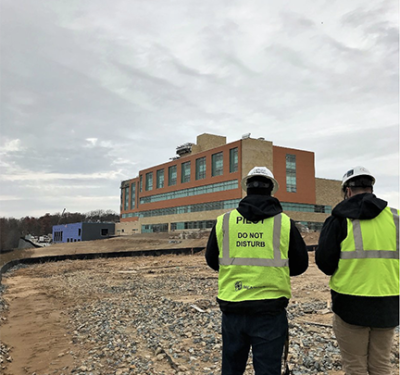
The Centaur aircraft, built by ASSURE partner Aurora Flight Sciences, can be flown with or without a pilot, and could be used to test new technologies.
The Federal Aviation Administration and its new coalition of unmanned experts are racing to meet an unusual deadline. They need to spend $5 million on unmanned aircraft research by the end of September.
There’s another $5 million in it for them if they make the deadline—and likely $10 million more next year.
Though there is a scramble on, the money is not exactly new. Congress stepped up last fall to give the FAA more resources toward opening U.S. skies to Unmanned Aircraft Systems (UAS). The funds were directed to a new Center of Excellence but became tangled in a budget fight. Then the money sat while the FAA selected a team to run the center.
But now, after two years without enough money to even fly at its own test sites, the FAA is set to pump some $20 million over 14 months into a wide range of studies aimed directly at integrating unmanned aircraft into the national airspace.
Turbocharged
The work will actually be done by the members of the Alliance for System Safety of UAS through Research Excellence (ASSURE)—a coalition of 21 top research universities selected in May to run the new National Center of Excellence for Unmanned Aircraft Systems (COE).
ASSURE is moving fast to get things set up. Within seven weeks of being chosen, the ASSURE team met with federal officials to work out research priorities, picked the lead schools for each area of study, and received back from its member universities research proposals to submit for FAA review.
Not to be outdone, the FAA is on track to assess, tweak and fund those proposals well ahead of the end of the fiscal year—its use-it-or-lose-it deadline.
“The FAA has moved extremely fast in getting our fiscal year 2015 money allocated,” said ASSURE Executive Director James Poss. “…We’re hoping to get that money obligated and back to the schools before September and actually get working.”
At least some of the credit for this double-time response goes to Poss, a retired Air Force Major General who flew reconnaissance missions during the Cold War and served in Desert Storm. Poss spent 30 years in the military, rising to become the Air Force’s senior career intelligence officer. He became deeply involved with UAS as the technology emerged as a key tool for intelligence gathering, surveillance and reconnaissance. He received the Aviation Week Curtis Sword Award in 2012 in recognition of his work establishing joint UAS operations.
The FAA grants have a dollar-for-dollar matching requirement so once the initial traunch of government money is in hand, Poss will be reaching out to ASSURE’s long list of corporate partners for that second $5 million.
“Every time the FAA gives us a dollar we have to get a dollar from one of our industry partners in corporate IRAD [independent research and development] money or assistance in kind—which is leases on UAS, consulting time, software licenses, equipment, that kind of deal,” said Poss.
And Poss will be making even more such calls early next year.
The House and Senate already have said they want to boost money for the FAA by as much as $5 million in Fiscal Year 2016 and the Senate wants to see the entire $5 million plus-up go to the COE. Though lawmakers still have some differences to work out, should they opt for the full, dedicated $5 million, that means—with the matching funds—that ASSURE will get another $10 million for unmanned, integration-focused research.
A good chunk of that money is likely to find its way to the FAA test ranges. Three of the ASSURE universities are already affiliated with at least one range and Poss made it clear that using the sites was a priority.
“We’re looking forward to working very closely and very synergistically with the test sites,” said Poss. “As a matter fact nearly all of our flying research will be done in one of the test sites unless there’s really a solid geographical reason that we just can’t accommodate that.”
Tying together the research agenda from the ground labs all the way through the actual flight testing is particularly efficient, said Matt Scassero, director, of the Mid-Atlantic Aviation Partnership (MAAP) test site at the University of Maryland.
“We believe they will be engaging the test sites to do the actual flight testing,” confirmed MAAP Executive Director Rose Mooney, who is based at Virginia Tech, “So I think there’ll be a good synergy between the COE and the actual selected test sites.”
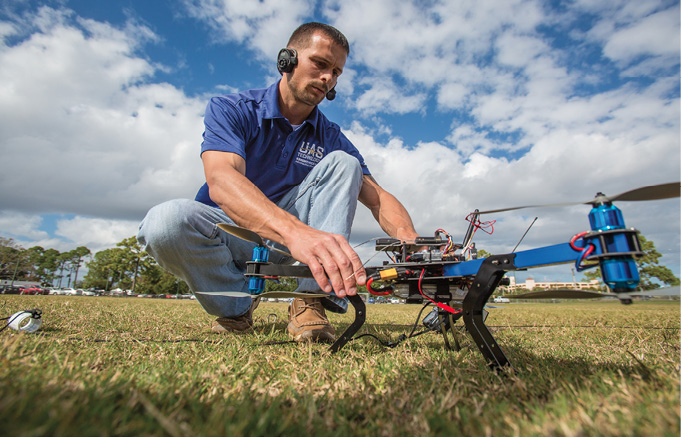
Embry-Riddle UAS club member prepares for a tethered flight with a quadcopter.
Seven Key Projects
To help coordinate work across all the agencies doing UAS research, the Center’s June kickoff meeting brought together not just the FAA and the ASSURE teams but representatives from the Department of Defense, NASA and the National Oceanic and Atmospheric Administration. In the end the FAA chose seven research areas on which to focus: airworthiness standards, beyond-line-of-sight flight, air collision research, ground collision severity, UAS maintenance personnel training and certification standards, surveillance criticality and human factors research. The last one includes developing standards for things like UAS flight controls as well as for training and certifying flight crews and visual observers. (See Sidebar Initial Research Priorities)
Given that many of the schools have been doing studies in these areas for some time, there is a good chance at least some of the new research will be available in time to help the FAA with elements of the small UAS rule even though the agency has been working on it for months.
Poss, for example, said ASSURE was hoping the ground collision research would inform the micro-UAS proposal before the agency—to either prove or disprove that a certain weight and composition of UAS “won’t have serious effects when it impacts something on the ground.”
One undertaking in particular could have wide-ranging ramifications. Five universities will collaborate to discover what is likely to happen during a mid-air collision between piloted planes and different types of unmanned aircraft. The research will rely largely on computer simulations but will involve some destructive testing including, possibly, tossing a UAS into a running jet engine to see what happens.
Jim Williams, the former head of FAA’s Unmanned Aircraft Systems Integration Office, expects the quality of the research to be very high.
“If you look at the members of that team,” said Williams, who now works for the law firm Dentons, “It’s like the A Team of unmanned aircraft research organizations around the country. I mean pretty much everyone who was well known is on that team.”
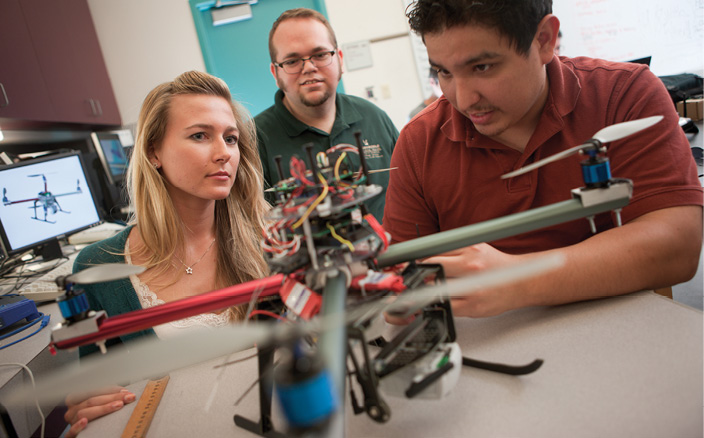
Students work with Dr. Richard Stansbury to prepare a UAS at Embry-Riddle’s Daytona Beach campus.
Private Sector
The expectations within the private sector are equally high—so high that more that 100 companies and other organizations already have signed on as ASSURE partners. Among those participating are major players like Lockheed Martin, Raytheon, Honeywell, General Atomics, General Dynamics, Amazon Prime Air, Kongsberg, L3 Unmanned Systems, Rockwell Collins, Sikorsky and Trimble.
The partners are expected to contribute funds, of course, but also their technology and expertise—something that can be of great benefit to all parties. If, for example, a firm submits equipment for experimentation, say a sensor for detect and avoid, the research will give them insight into its integration and performance, explained Paul Lindseth, associate dean of the John D Odegard School of Aerospace Science at University of North Dakota. Moreover, the results of such a study could help frame the FAA’s decisions on detect and avoid.
This approach is typical of the way Centers of Excellence are structured, said Lindseth, who is his school’s principal investigator for the ASSURE team.
“It’s basically a combination effort between the FAA and the universities and the corporate sponsors,” Lindseth explained, with most companies contributing their knowledge and skills to the project. “That’s the way the centers of excellence have always been set up.”
Lindseth stressed that COE researchers are independent. While the firms may provide input, he said, they do not control the findings.
That is an advantage, said John Langford, chairman and CEO of ASSURE partner Aurora Flight Sciences. “I think the Center of Excellence will help by providing an objective view on some of the more controversial questions.”
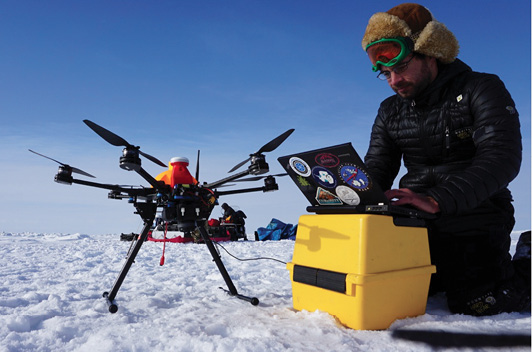
Alaska team member Eyal Saiet operating the Ptarmigan UAS on sea ice.
Broad Benefit
Another big advantage of doing research through a Center of Excellence, suggested Langford, is that the results are widely distributed.
“Very little of the unmanned research done so far by NASA and the FAA has been pushed out into the broader community, especially the research community,” Langford told Inside Unmanned Systems. “And you know that the way most aeronautical R&D has really happened in this country over the last hundred years is through a coalition of government, university and industry partnerships. That’s been kind of missing on the UAV (Unmanned Aerial Vehicle) side and ASSURE is going to restore the balance into the system that’s been so successful over the last hundred years.”
“The data that we collect will almost universally be made public,” confirmed Poss. “The whole idea is to get the nation comfortable with flying new UAS in our national airspace, backed up by well thought out research data that proves every one of the rules that the FAA is coming up with for unmanned.”
Formal research papers will be published once they are vetted, he said, and ASSURE members will be speaking at technical conferences. ASSURE also will be making data available for schools to incorporate into training and certification courses and even bachelor level degree programs.
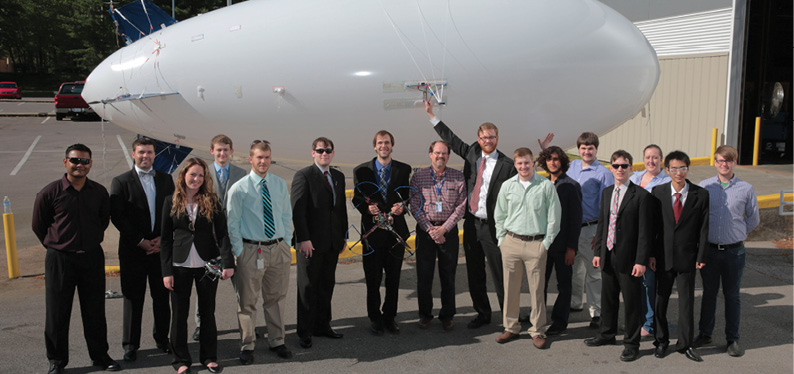
Long-Term Plans
Though the researchers have up to three years to complete their work, Poss wants to see most of the initial COE research completed in the next 12 to 18 months. “Then we’ll provide that research to the FAA and will use that to make rules to get commercial UAS flying in the national airspace.”
Converting the study results into rule form requires its own kind of expertise. In fact, said Poss, some of ASSURE’s academic members were picked specifically for their experience in bridging the gap between research and rulemaking.
“At last count ASSURE schools were on 13 different rule-making committees both nationally and internationally,” he told Inside Unmanned Systems.
Poss, however, wants ASSURE to push beyond the immediate FAA-funded research to a level of activity designed to unleash the industry by supporting more advanced rule making.
To do this Poss is reaching out to industry to get additional resources.
The goal, he said, is to “talk about dividing up FAA shortfalls in research and making sure that they’re covered either with contributions of corporate research money to ASSURE or done cooperatively between corporate researchers and ASSURE researchers to make sure that the FAA gets the research that it needs to turn into UAS rules for our country.”
This is not a hard sell. Companies desperate to see drones integrated more quickly and restrictions lifted on operations like beyond-line-of-sight flights have been offering publically to help fund research for several years. CNN, BNSF Railroad and PrecisionHawk recently joined with the FAA in pathfinder projects, pledging their own resources to speed things along.
ASSURE is already expanding on this idea. Several industry partners met with COE representatives at the Paris Airshow, Poss told Inside Unmanned Systems, saying they’d be willing to discuss pooling their resources to support the UAS research the FAA isn’t able to fund.
“That was a big break.,” said Poss. Helping ASSURE further engage with the private sector will be a very familiar face—that of Michael Toscano, the former president and CEO of the Association for Unmanned Vehicle Systems International (AUVSI), the world’s largest unmanned industry association.
Toscano is the incoming executive chairman of ASSURE’s external advisory board, said Poss. In this new position he will be “helping us reach out to those industry partners that we’re going to ask to contribute resources to fund FAA shortfalls.”
The problem-solving power in ASSURE’s 21 universities and growing list of partners will undoubtedly make Toscano’s job easier. If that power is brought to bear on challenges like safe, automated delivery flights or a practical detect-and-avoid system, it is hard not to believe the ASSURE team can find the answers and ultimately see those answers implemented.
Langford, who got to know Poss while he was n the Air Force working on intelligence, surveillance and reconnaissance; much of it with UAS,described him as a “thought leader” and the “guy at the tip of the spear” when it came to making things work day-to-day.
Now the former general is again at the leading edge, crafting strategy and marshaling considerable resources to make practical use of the raw potential of unmanned technology.
“Jim Poss,” observed Langford, ‘is really well positioned.”





